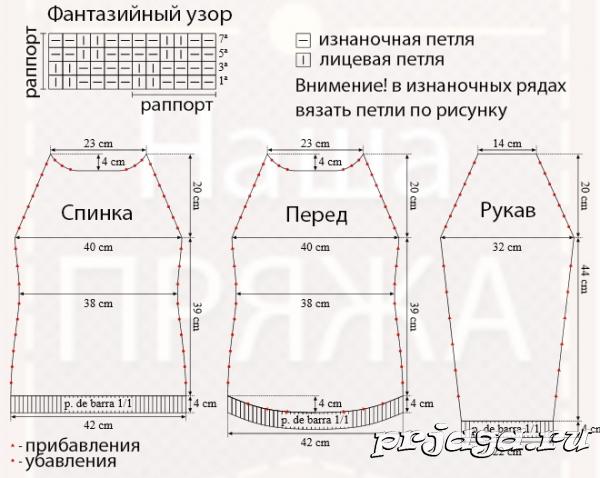Raglan sweater made of knitting needles from the bottom up. Simple knitting looks stylish and elegant.
Dimensions women sweaters: 34/36 (38/40) 42/44
Very effective model. will become the basic thing in your fall-winter wardrobe, it can be combined with anything. This model will add extravagance to any everyday kit.
In this shortened raglan sweater, wool yarn of gray shades looks especially expressive. This is a universal model for winter.
Finally it's time to put on warm women's sweaters. In winter, I want to wrap myself in cozy knitwear. We offer you an amazing warm raglan sweater made of wool yarn.
The model consists of four parts, which are then stitched together.
For knitting women sweaters you will need:
550 (600) 650 g of gray yarn (100% wool, 80 m / 50 g);
straight knitting needles number 4,5.
Front surface: front rows - front loops, wrong rows - wrong loops.
Average knitting density: 16 p. And 35 p. \u003d 10 x 10 cm; facial smoothness: 16 p. and 24 p. \u003d 10 x 10 cm.
Description of knitting women's sweaters.
Back / front: on the knitting needles with a cross-shaped set 78 (84) 90 p. and knit with a garter stitch. After 11 cm \u003d 38 p. from the typesetting edge continue to work with the front stitch. After 26.5 cm \u003d 64 p. (24 cm \u003d 58 p.) 21.5 cm - 52 p. from garter stitch close on both sides for raglan lines 3 p. \u003d 72 (78) 84 p. Next, knit both the first and last two loops with a garter stitch and reduce on both sides 21 (24) 27 x in each 2nd p. 1 point as follows: knit the 3rd + 4th point together with the front on the left side, knit the 4th + 3rd from the end of the row of loops with the broach on the right side (\u003d 1 point, remove as with face knitting , knit the next loop to the front and pull through the removed loop). At the same time, after 42.5 cm \u003d 102 p. From the garter stitch, knit all the loops another 2 cm \u003d 6 p. garter stitch. The remaining 30 p. Close after 55.5 cm \u003d 146 p. from garter stitch.
Sleeves: put on the knitting needles with a cruciform set of 48 (54) 80 p. and knit with a garter stitch. At the same time, for bevels, add on both sides, starting from the set edge, 6 x 1 p. Alternately in each 10th and 12th p. .. including added loops in the pattern \u003d 60 (66) 72 p. After 20.5 cm - 72 R. from the typesetting edge, make reductions on the raglan lines on both sides, as described for the back. After 33 cm \u003d 116 p. (35 cm \u003d 122 p.) 37 cm \u003d 128 p. close the remaining 12 p.
Knitted raglan sweater with knitting needles fancy texture surface pattern
Women's Raglan Sweater Knitting
To knit such a raglan sweater with knitting needles, special knitting skills are not enough, a beginner level is enough, because such a pattern was created with the simplest knitting elements - front and back loops.
The size: European 40/42; Russian 46/48
Materials: 7 skeins of yarn Cisne Celta 93% acrylic, 7% polyester, 100 g / 120 m.), Knitting needles No. 5.
Knitting density: 15 loops * 20 rows \u003d 10 * 10 cm.
How to knit a raglan sweater with knitting needles, description:
Back: on knitting needles dial 64 loops.
Perform an elastic band of 1 person. / 1 \u200b\u200bout.
Before: on knitting needles dial 24 loops.
Start performing an elastic band of 1 person. / 1 \u200b\u200bout., At the same time, on each side in each second row 5 loops - 4 times \u003d 64 loops on the knitting needles.
At a height of 4 cm, begin to carry out a fantasy pattern according to the scheme, add 1 loop on each side in each sixth row - 6 times.
Knit 6 rows without additions.
Then reduce 1 loop on each side in every sixth row - 4 times.
At a height of 43 cm, start reducing the raglan: knit 2 faces., 2 together. Persons, knit with a fancy pattern until the last. 4 loops, 2 persons together. behind the back wall, 2 persons.
Repeat decreasing alternately in every second and fourth rows - 13 times.
At a height of 16 cm from the beginning of the raglan, close the central 16 loops for the neck, knit the sides of the back separately.
Perform reductions on each side of the neck, in each second row 1 loop - 2 times, 7 loops - 1 time.
Sleeve: on knitting needles dial 34 loops.
Perform a fantasy pattern according to the scheme, add 1 loop in each tenth row - 7 times on each side.
At a height of 48 cm, begin to reduce the raglan: knit 2 persons., 2 persons together., Knit with a fancy pattern until the last. 4 loops, 2 persons together. behind the back wall, 2 persons.
Repeat decreasing alternately in every second and fourth rows - 13 times.
Close the loop.
Assembly and decoration of the neck: stitch one shoulder.
Raise the hinges around the neck of the back and front.
Perform an elastic band of 1 person. / 1 \u200b\u200bout. - 4 cm.
Close the loop.
Stitch the second shoulder, stitch the collar seam.
Sew on sleeves.
Sew the sides and seams of the sleeves.
Knitted raglan sweater, knitting pattern



